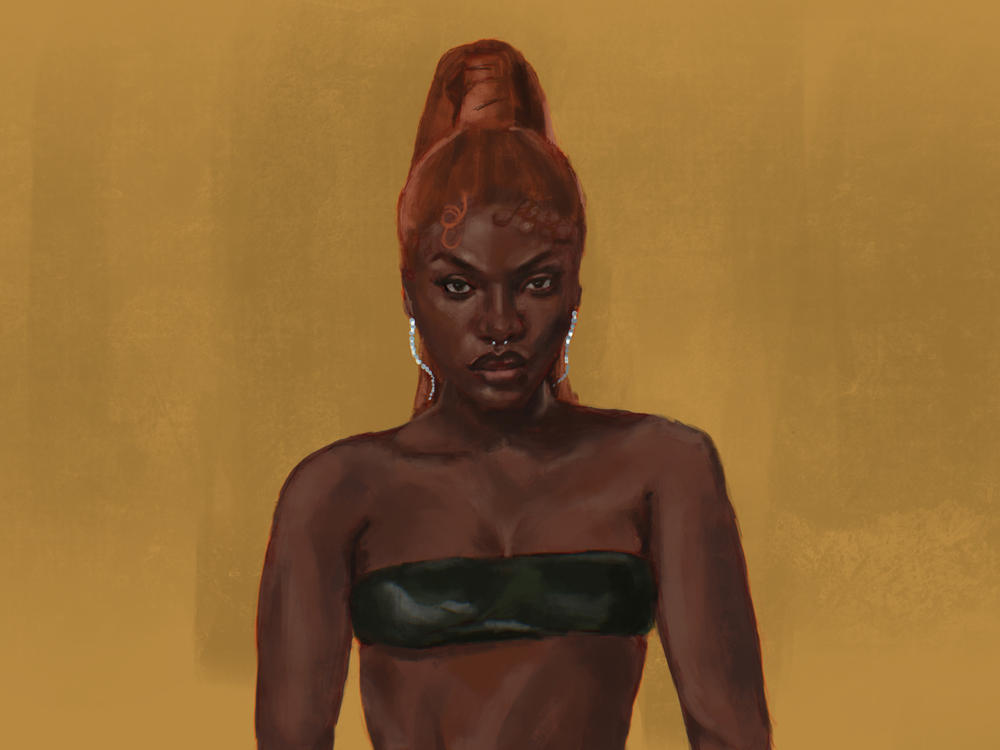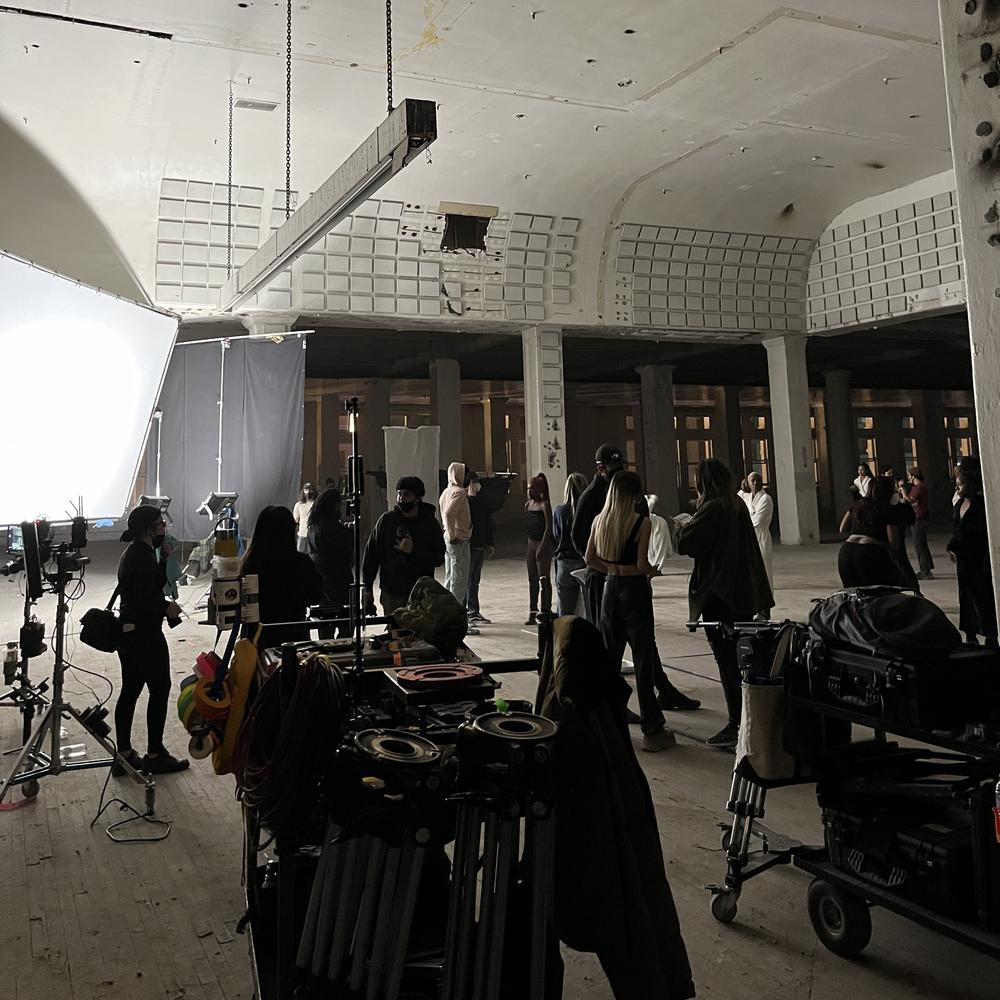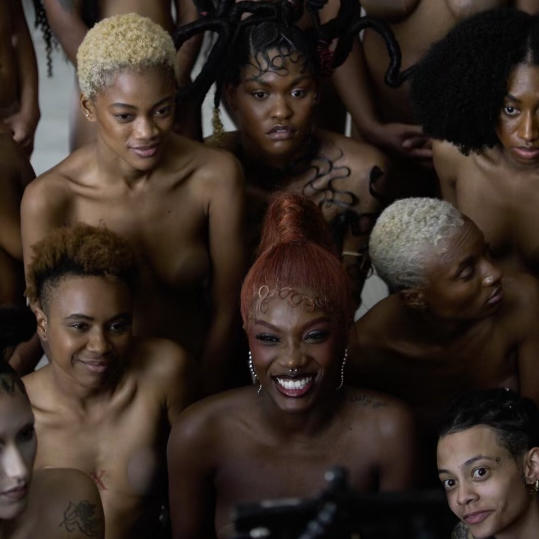Section Branding
Header Content
'I'm coming to y'all with no armor'
Primary Content
This story was adapted from Episode Three of Louder Than A Riot, Season Two. For more about body policing in hip-hop, including tales of cosmetic surgery, peer pressure and comment culture, stream the full episode or subscribe to the Louder Than A Riot podcast.
Childish Gambino's "This Is America." Cardi B's "Press." Lil Nas X's "Industry Baby." Scroll through popular music videos and you'll see nudity and violence on the daily. Some use their provocative content to make political and social statements; plenty of others use half-dressed vixens as props, most often for high-profile men. But no matter a video's content, YouTube is where most viewers will see it, where entire careers can be launched off the right combination of sight and sound.
Long before she was making her own videos, Tampa rapper Doechii picked up on an unspoken rule about popular media's relationship with nudity: No matter the context, no matter the artistic intent, a Black woman's body will almost always be seen as inherently sexual. A year ago, she tried to confront that rule head on — and learned that even now, years into our era of digital democracy, no platform is without a point of view.
Doechii isn't just one of the latest signees to powerhouse rap label TDE — she's also the first woman on the roster who raps. (She had to be nice to earn that spot, and she knows it.) From the minute she signed she was throwing around big ideas for her look, her sound and her message. In 2022, just as Kendrick Lamar was dropping his ostensible final release for the label, Doechii began promoting her first, an EP titled she / her / black bitch.
"People have always called me crazy when they don't understand what I'm doing, or they want me to feel bad about the boldness or the ambition or the audacity," Doechii says. "I've kind of morphed myself into realizing the power of being the black bitch, realizing the power of being painted as the villain."
She channeled that energy into her debut single, "Crazy" — a chaotic yet confident track that calls out the doubt and double standards she's always faced as an artist, reclaiming the word by screaming it back. When it came time to make visuals for the song, she wanted to push that notion even further. Her inspiration was a card from the tarot deck: The Star.
"There's a woman who's naked bending in the water, and this is her fullest potential," she explains of the image. "I wanted to introduce myself to the world and debut my first single naked — as a symbol of vulnerability, but also ultimate power."
Doechii's vision for the "Crazy" video called for nudity as a main ingredient, but not in a way meant to be at all sexual or pleasurable. Instead, she hoped to use her naked body in opposition to the male gaze, challenging pervasive ideas about nakedness in general and Black women's bodies in hip-hop specifically.
Hiring a director wasn't easy. Doechii says most people she approached about the project were afraid to take it on, or even tried to talk her out of it. Not that she was surprised: In the streaming era, for a video to make monetary sense it has to do well on YouTube, a platform with a spotty record for policing Black bodies (never forget that the company was literally started so people could get a second look at Janet Jackson's nipple back in 2004). Pulling off the plan for "Crazy" would mean confronting some deeply entrenched misogynoir. Luckily, Doechii found someone willing to go to war with her.
"Femmes are sort of under undeniable, inescapable gaze at the body," says Sarah Prinz, a Los Angeles director and choreographer better known as C Prinz, who has worked with artists including Billie Eilish, The Weeknd and Chloe Bailey. "We have to carry on doing all of the things that we do with that gaze on us. And it was sort of my mission to charge the bodies, and charge the story, in a way that you almost forgot about the nudity."
Prinz came up with a video treatment Doechii loved, which would put her in a dystopian setting at the head of a squad of dancers, all of them nude. Tiny coverings and visual effects would obscure the nipples and genitals, but just barely. The artist had only one note for the director: Prinz had pitched filling the frame with every skin color she could find, but Doechii said she wanted an all-Black cast.
"Everybody should be included, but there are just some stories that are for a specific group of people," Doechii says. "For this video, I wanted to curate a space specifically for Black women — of all different colors, but Black women specifically. That's what I wanted to focus on. I wanted it to be for us, by us, danced by us, created by us."
Their vision was coming together. Then, a week before they were set to start shooting, Prinz was asked to join an emergency Zoom call. "Everybody's on the line — like, 10, 11 people there," she recalls. "And I'm like, what's this about?" Prinz says Moosa Tiffith, the president of TDE, explained to her that word had gotten around about what was planned for the "Crazy" video, and that there were some reservations from the label and management.
Tiffith, who was responsible for bringing Doechii to TDE in the first place, adds that his concern was for the artist's sake as well. "I want to protect her. I don't want to see her disrespected in no type of way," he says. "For some reason, we wasn't aware she was gonna be naked the entire shoot. I don't think it was a concern of how it's gonna come off — it was just a moment where we were like, hey, how did we let this slip under the rug?"
It's easy to write off Tiffith's apprehension to Doechii's idea as fear — and yet, fear is the exact impulse that structural patriarchy preys upon, nudging individuals to move in line with the system. Fighting that instinct was the whole point of the project, so C Prinz doubled down. The video would go forward, no compromises.
After many months of prep and rehearsal, "Crazy" was filmed in a marathon shoot, with the cast and crew on set for almost 14 hours. The video opens about as bluntly as it could, with Doechii shooting someone in the head with a handgun. From there, everything ramps up: She and the dancers smash cars, set fires, spray shots from machine guns, put cigarettes out on their skin. In the final seconds, the viewer learns that the woman Doechii shot at the start of the film was actually Doechii herself.
"Usually if somebody's shooting, or there's guns or war, people have on armor. And I wanted to symbolize how me coming into the industry as vulnerable as I am, I'm coming to y'all with no armor. You could shoot me and you could kill me right now, and I would be done for," Doechii says. "Especially with women in hip-hop, hurting me is hurting you. You kill one, you kinda killing yourself."
Even amid all the anarchy, there's a communal energy that is palpable onscreen: An army of Black women wage war in an empty parking lot just because they can, just because they feel like it, all while completely naked. Off-camera, that solidarity manifested in a commitment to safety on set. An intimacy coordinator was hired to supervise the shoot and rehearsals, and if the talent ever felt uncomfortable they could give a silent signal — arms crossed over the chest, like the Wakanda salute — and someone would intervene. Kryss Hicks, one of the dancers, says she realized the power of that resource during a dress rehearsal, which turned out to have a few extra eyes in the room.
"There were people from TDE, I believe, who was there just watching us rehearse. And they pulled us to the side and they were like, 'There are people from the label. They don't have to be here right now. Do you feel comfortable?' ... I spoke up and I was like, yeah, I don't ... I gotta warm up to that. And they asked them to leave," Hicks explains. "Out of all music videos that I've done — and mind you, I really just dislike doing music videos — but this was definitely the safest space I had ever been in on set."
When "Crazy" wrapped production, everyone went home proud of what they'd created. But a bigger hurdle was ahead: TDE had to prepare to release the video, which meant the content moderators at YouTube would have a chance to weigh in. Moosa Tiffith says he had a label rep send the video to YouTube ahead of time, and the news back was disappointing.
"They told us they couldn't allow it to trend because the women were naked in the video," Tiffith says. "But I mean, technically they're covered up, you know what I mean? I've seen worse on YouTube. We had several conversations with them, going back and forth for probably about a good two weeks. But they were just firm on what they were saying — like, hey, unless it's a way you guys can VFX some clothes onto these ladies, then we can't allow it."
YouTube wouldn't budge. In the end, the video was age-restricted. That meant it wasn't eligible to trend, dealing a major hit to its searchability and visibility. We reached out to a representative from YouTube, who denied our interview requests for this story. But when we asked what specifically about this video broke their community guidelines, they pointed us to the platform's nudity and sexual content policy, which reads in part: "Explicit content meant to be sexually gratifying is not allowed on YouTube."
The irony in that language is almost too clear. Doechii's entire thesis in making the video had been to combat the male gaze, to present exposed femme bodies as anything but sexually gratifying, to operate within the stated rules of the game. The decision-makers in charge saw it as the exact thing it was made to defy, and deemed it guilty on all counts.
The "Crazy" video dropped on YouTube on April 8, 2022. Doechii remembers that in that moment, she wanted to feel heroic, but in truth, she felt scared. She'd briefed her mother on the concept but didn't know how the rest of her family, let alone a global audience, would react.
"Even though it's an important message for me, I was just scared that I would hurt people's feelings, or I would offend Black women and they wouldn't get it," she says. "But it turned out being the opposite — they really, really f***ed with it. A lot of Black girls said that they just loved to see a dark skin Black girl in a non-sexualized way. And I thought that was dope."
But that was even if they got to see it. For all the time, money and intention put into the video, "Crazy" never hit YouTube's homepage. It only recently crossed 1 million views, 11 months after its release — a milestone for any artist, but small time compared to up-and-comers on the platform with the same level of industry interest behind them.
Nevertheless, Doechii has spent the past year continuing to put her artistry on display. She showed the power of her body in movement in the video for "What It Is (Block Boy)," and, perhaps just as provocatively, covered all but her face in her performance of "Stressed" for the online series COLORS. "Crazy" may not have started the larger dialogue she'd hoped for, but she's never regretted the risk she took.
"It doesn't affect my creativity. I'm still gonna keep pushing these messages; I'm still going to keep challenging these systems and these ideals that people have. But, I mean, it does affect me, because look what happened — less people can see it because of these rules and things that are in place. So it's not gonna affect my creativity, but it is going to affect the amount of people that are able to experience my art," she says.
This hypocrisy Doechii is talking about isn't that hard to see — if you're able to look past the veil of the male gaze. For her part, witnessing the censored release of "Crazy" is a perfect argument for why art like it needs to exist in the first place.
"This goes back to the point of why I'm making the type of music I make, and why I put out these type of visuals," she says. "I want it to be to a point where Black women, specifically, can be limitlessly creative — and we don't have to be policed."
Copyright 2023 NPR. To see more, visit https://www.npr.org.



